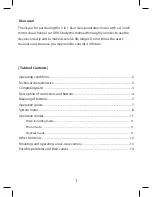
168
Precautions
x
Do not use/store the camera in the
following places
• In an extremely hot, dry or humid place
In places such as in a car parked in the sun, the
camera body may become deformed and this
may cause a malfunction.
• Under direct sunlight or near a heater
The camera body may become discolored or
deformed, and this may cause a malfunction.
• In a location subject to rocking vibration
• Near strong magnetic place
• In sandy or dusty places
Be careful not to let sand or dust get into the
camera. This may cause the camera to
malfunction, and in some cases this malfunction
cannot be repaired.
x
On carrying
Be sure to attach the lens cap or body cap when
not using the camera. When attaching the body
cap, remove all the dust from the cap before
placing it on the camera.
x
On cleaning
Cleaning the LCD monitor
Wipe the screen surface with an LCD cleaning kit
(not supplied) to remove fingerprints, dust, etc.
Cleaning the lens
• When cleaning the lens surface, remove dust
using a blower. In case of dust that sticks to the
surface, wipe it off with a soft cloth or tissue
paper slightly moistened with lens cleaning
solution. Wipe in a spiral pattern from the center
to the outside. Do not spray lens cleaning
solution directly onto the lens surface.
• Do not touch the inside of the camera, such as
lens contacts, or the mirror. Since dust on the
mirror or around the mirror may affect the auto
focus system, blow away dust using a blower. If
dust lands on the image sensor, it may appear on
the photo image. Turn the camera to the
cleaning mode (page 125), then clean it using a
blower. Do not use a spray blower to clean the
inside of the camera. Using this may cause a
malfunction.
• Do not use a cleaning solution containing
organic solvents, such as thinner, or benzine.
Cleaning the camera surface
Clean the camera surface with a soft cloth slightly
moistened with water, then wipe the surface with
a dry cloth. Do not use the following as they may
damage the finish or the casing.
• Chemical products such as thinner, benzine,
alcohol, disposable cloths, insect repellent,
sunscreen or insecticide, etc.
• Do not touch the camera with the above on your
hand.
• Do not leave the camera in contact with rubber
or vinyl for a long time.
x
On operating temperatures
Your camera is designed for use under the
temperatures between 0 and 40°C (32 and 104°F)
(When using a Microdrive: 5 and 40°C (41 and
104°F)). Shooting in extremely cold or hot places
that exceed this range is not recommended.
x
On moisture condensation
If the camera is brought directly from a cold to a
warm location, moisture may condense inside or
outside the camera. This moisture condensation
may cause a malfunction of the camera.
How to prevent moisture condensation
When bringing the camera from a cold place to a
warm place, seal the camera in a plastic bag and
allow it to adapt to conditions at the new location
over about an hour.
If moisture condensation occurs
Turn off the camera and wait about an hour for the
moisture to evaporate. Note that if you attempt to
shoot with moisture remaining inside the lens, you
will be unable to record clear images.












































